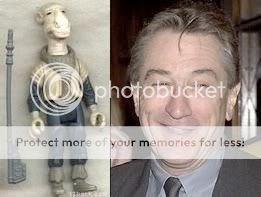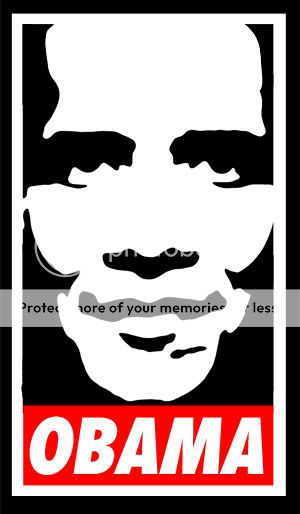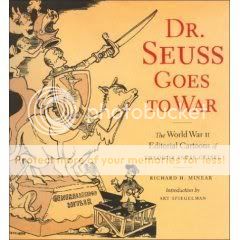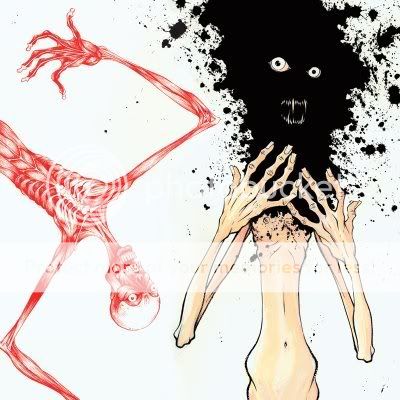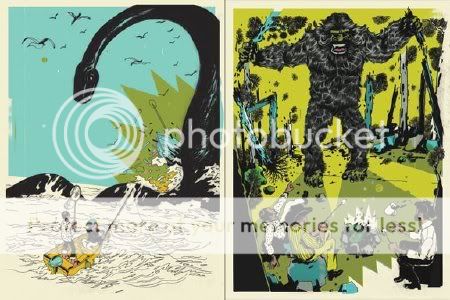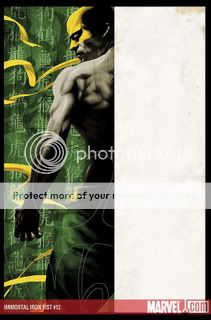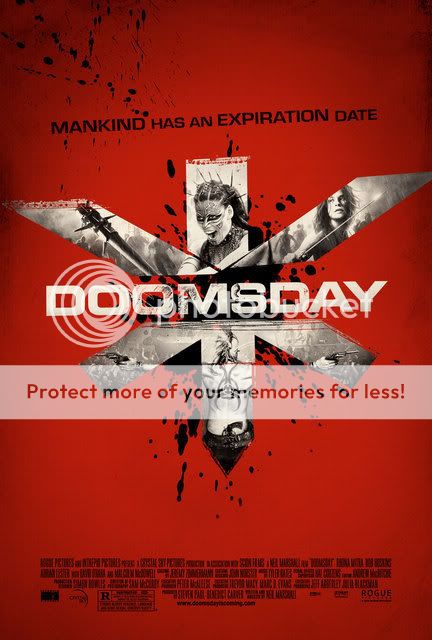Author Archive
Carnival of souls
February 9, 2008* Get a load of this: The Los Angeles Opera is making an opera out of David Cronenberg’s The Fly. And get a load of the creative team: Music by Howard Shore (The Lord of the Rings, The Silence of the Lambs, and countless Cronenberg movies), book by David Henry Hwang (M. Butterfly), design by Dante Ferretti (Gangs of New York, Sweeney Todd), conducted by Placido Domingo (of Three Tenors fame) and directed by Cronenberg himself. Damn! (Via Ian Brill.)
* Neither Stacie Ponder of Final Girl nor Jason Adams of My New Plaid Pants liked George A. Romero’s new docu-zombie movie Diary of the Dead. This doesn’t bode well.
* Dread Central reports that Romero’s next project may be Diamond Dead, an off-beat non-Dead-verse story he’d tried to get off the ground once before about a rock singer who makes a deal with death to bring her band back to life.
* Dread Central also says that Alexandre Aja’s remake of Piranha (!) might now be 3-D. It’s funny: I still remember the brief moment after Haute Tension when this guy was supposed to be the future of horror. But hey, I actually prefer the idea of a 3-D movie about man-eating fish to anything else Aja’s been associated with thus far.
* Loren Coleman of Cryptomundo has the goods on author William Gibbons’s upcoming book about the mokele-mbembe, the living dinosaur that supposedly roams the Congo basin (and maybe my favorite cryptid). He also posts some cool out-of-context photos of the boxed-up Gigantopithecus replica from the breakdown of the American Museum of Natural History’s Mythic Creatures exhibit.
* Another “Get a load of this” moment: Behold, a six-gilled shark with a meter-wide head and an 18-foot body, swimming around at 3280 feet below the surface. You’ve gotta love the beside-themselves commentary from the researchers.
(Via Deep Sea News via Kennyb.)
* Finally, this week’s Horror Roundtable is one of my favorites in a long time: Name your favorite horror-movie cliche! Best of all, every single participant has a different answer. Feast your eyes, glut your soul!
Comics Time: Mother, Come Home
February 8, 2008Mother, Come Home
Dark Horse, November 2003
Paul Hornschemeier, writer/artist
128 pages
$14.95
Buy it used through Amazon.com
Originally written on March 3, 2004 for publication by The Comics Journal
2003 saw the release of gargantuan tomes like Palomar, The Frank Book, and Blankets, so it might seem facetious to claim that the year’s most ambitious graphic novel was a 128-page paperback. But how else to describe Mother, Come Home, a book wherein author Paul Hornschemeier’s formidable formal mastery is harnessed to an even more consciously grand personal tragedy? This is the kind of storytelling that’s as likely to fall flat on its face as it is to fly. Hornschemeier’s willingness to throw the full weight of his skill into this task is what ensured the latter outcome.
Originally serialized in the author’s Forlorn Funnies series, a more narrative-minded follow-up to his experimental one-man anthology Sequential, Mother tells the story of Thomas Tennant, a preternaturally conscientious seven-year-old dealing with the death of his mother and his father’s subsequent disappearance into his own broken mind. Interstitial titles set up the conceit that the novel is merely the “introduction” to a larger work, the first “chapter” of which is to be called “We Are All Released.” In this alone–that is, in grafting an unnecessarily complex framing device onto the story in order to deliver the four-word message of hope at the book’s end–Hornschemeier’s artistic fascination with the tension between control and freedom is evident.
It’s a tension that’s at work on every page. The cartoonist’s considerable skill in graphic design manifests itself in a panoply of geometric intra-panel layouts–boxes bisected by a furrowed brow, the edge of a door, the bend of a telephone receiver. It’s not specific images that stand out upon reflecting on Hornschemeier’s art, but unexpected diagonals and rounded corners, a sort of poetry of shape. But when Thomas retreats into his fantasy life, this everything-in-its-right-place precision is forgone for scratchy, simplistic, childlike linework. The escape Thomas plans for his father is made manifest in the boy’s own dreams.
Much has been made about Hornschemeier’s skill as a colorist, and his work in that department is every bit as deft as you’ve heard, but his lettering merits special mention. Throughout the book, the characters’ words are subtly dwarfed by the word balloons that contain them. This simultaneously suggests a certain generosity of spirit, a yearning for something more than what is being expressed, and a recognition of the futility and smallness of language to deal with the immensity of the suffering going on beneath, and on, the surface. (And it does so on the parts of both the characters and the creator, by the way.) Individual moments linger, too: Within the father’s fantasy, it’s the comments that seem the most casual which expand to fill their entire panels, conveying a sort of frantic off-handedness that smacks also of denial; lower-case lettering slips off-line and expands in manic curlicues, perfectly conveying Thomas’s hysteria upon realizing he’s alerted his uncle to his father’s breakdown. Meanwhile, the simplicity of the captions’ lettering offsets the occasionally baroque prose (perhaps bulletproofing the book against the kind of criticism occasionally leveled at Craig Thompson’s similar linguistic stylings in Blankets).
What elevates the book from graphic-designers-gone-wild wankery, though, is the way these devices perfectly complement and convey the values of the narrative. As Thomas and his father’s family falls apart, the two of them adopt a succession of tactics–a lion mask, a retreat into solipsism, a rigorously followed “groundskeeping” routine, a residential treatment facility, methodical escape plans–to exert control over the unbearable chaos of their lives, precisely for the purpose of freeing them from it. The tension-breaking achieved on a formal level by Hornschemeier’s occasional insertion of exhilarating out-of-nowhere experimentation (the floating fantasy introduction; the full-page jacket-cover illustration for another book with a tendentious relationship to the story itself; the nighttime views of the book’s sleeping characters, from the most important to the most obscure) is echoed on the narrative plane by flashes of humor (Thomas’s hilarious smackdown of his teacher makes up for her somewhat unrealistic (and unforgivable) behavior) and immensely warm pathos (the exchanged glances between a smiling Thomas and a scowling nurse are worth the price of admission alone for their heartbreaking directness). It culminates in a climax that by all rights should seem ham-fisted and forced, and yet works, emerging as it does from intensely intimate (and therefore immediately understandable) details of touch and sight and (not) taste–tiny, sensate building blocks of calamitous inevitability. What hints of too-neat tragedy remain are torn to pieces by the book’s final words, and the forward-looking eeriness of the image that accompanies them.
Mother, Come Home is the work of a young cartoonist who, confident in his craft, decided to do something big with it. For his ambition alone–which, thankfully, is far more common amongst his cartoonist peer group then its reputation as a collection of coasting glad-handlers would have it–he is to be respected. For his success–his indelible, beautiful, and heartrending graphic novel, the type of book for which the phrase “auspicious debut” was invented–he is to be celebrated. His book is a joy to read; the fact that this is a feeling forbidden to the characters therein makes it all the sharper, and sweeter, and harder to forget.
Carnival of souls
February 7, 2008* B-Sol at the Vault of Horror brings us a rundown of George A. Romero’s appearance on the Opie & Anthony show today, including the zombie king’s comments about Land of the Dead, Zombi 2, Resident Evil, Saw, Hostel, World War Z, and whether any racial commentary in the original Night of the Living Dead was intentional.
* Various sites are reporting that the Hellraiser remake supposedly has a January 9th, 2009 release date.
* Eve Tushnet spots an interesting quote from Camille Paglia’s Sexual Personae, calling the rise of doppelganger/double horror during the Romantic era a reflection of those writers’ replacement of church and state with the Self as the ultimate authority.
* My All Too Flat-mate Ken Bromberg drew my attention to this creepy Wikipedia entry on “rat kings,” cryptozoological clusters of rats whose tails have become inextricably entwined.
* The FBI and various police agencies arrested almost the entire Gambino family hierarchy today—except for one captain who lammed it, making the story even more awesome than it already was.
* Rob Humanick of The Projection Booth and The House Next Door has declared February 22-28 the VHS Blogathon, celebrating the unique phenomenology of the late, lamented format of our collective youth.
* Steven Wintle of the Horror Blog will be spending the next year participating in a weekly gladiator-movie podcast based off one of those 50-movie DVD value packs, god help us.
* I’m not as wowed by her covers for Runaways and Buffy the Vampire Slayer as others seem to be, but this preview art for Jo Chen’s new manga The Other Side of the Mirror is just gorgeous. Just look at the line placement alone. (Via Tom Spurgeon.)
* Finally, should female dragon people have tits?
Carnival of souls
February 6, 2008* I read this story about community activists forcing a Union City, Indiana McDonald’s to remove all R-rated movies from its Redbox dollar-a-night DVD-rental kiosk with great interest. Besides the fact that I always find such efforts distasteful, I’ve noticed that the Redbox at the supermarket where I shop is stocked almost wall-to-wall with horror movies–many of which are of the straight-to-video variety, which depend almost entirely on rentals for revenue–and these genre efforts would obviously be a prime target of bluenosed initiatives like this.
* Speaking of video rentals, Robbie Freeling gives a shout-out to old-school neighborhood video store horror section posters and box art.
* CRwM of And Now the Screaming Starts reviews Josh Simmons’s excellent horror graphic novel House.
* Johnny Bacardi points out the weaknesses of the neither-here-nor-there cartoony realism of the Vertigo house style.
* Marvel editor Tom Brevoort hosted a Marvel-only best-of award vote at his blog, and the results are refreshing because the best writer at Marvel right now, Ed Brubaker, and the two best books at Marvel right now, Brubaker’s Captain America and The Immortal Iron Fist, really clean up. (Via Graeme McMillan.)
* In the middle of a crazy interview centering on the identity of Britt Ekland’s ass double in The Wicker Man, director Robin Hardy and star Christopher Lee deliver a pair of absolutely killer quotes about their upcoming semi-sequel to the film, now evocatively titled Cowboys for Christ:
[Hardy] described his follow-up movie as “another film with beautiful songs, sassy sex, a few good laughs and horror upon horrors ahead”.
And:
“The reason I want to work again with Robin is because he has written a book that is erotic, romantic, comic and horrific enough to loosen the bowels of a bronze statue,” [Lee] said.
Yee-haw! (Via Bloody Good Horror.)
* Finally, my old friend from ToyFare magazine, Zach Oat of Topless Robot, presents the Top 10 Star Wars Toys That Unintentionally Look Like Other Celebrities.
Comics Time: Death Note Vol. 1
February 6, 2008Death Note Vol. 1
Viz, September 2005
Tsugumi Ohba, writer
Takeshi Obata, artist
Pookie Rolf, translator/adapter
200 pages
$7.99
It’s hard not to cackle with glee at how neatly Death Note fits into the scary-media pantheon, filling a slot previously occupied by Marilyn Manson, Beavis and Butt-Head, Bart Simpson, Grand Theft Auto, N.W.A., Natural Born Killers, Dungeons & Dragons, and so on all the way back to the days of Elvis Presley and EC Comics. The premise–a straight-A student discovers a death god’s notebook, and anyone whose name he writes in it dies–is practically guaranteed to send authorities into a Chicken Little panic. It’s not the world’s most artful effort: like most translated manga, scene transitions are awkward and dialogue comes out in weird little bursts, while the figurework is sturdy but pretty standard and the characters play comfortably to type.
But it shines in a couple of regards besides that initial, killer high concept. I really enjoy the way Obata spots blacks; they’re pitch dark and almost geometric, as though the page is occasionally partially posessed by a slightly greasier Mike Mignola. And they come together in the form of Ryuk, the death god whose comically lanky larger-than-life presence and googly-eyed, permanently grinning, static shock of a face is a continual source of chuckles for me in its ostentatious weirdness. The other highlight is Light, the model high-schooler who within a few hours of finding the death note has become an archcriminal capable of baffling the combined law enforcement agencies of the entire world with his plot to exterminate the global criminal underclass and force everyone else into good behavior via paranoia. I’ve grown reluctant to harp on sociopolitical messages in genre work, but the idea here seems to be that Japan’s insanely intense educational culture produces miniature sociopaths, and that’s just plain funny. Right now the cat-and-mouse games aren’t engaging in any visceral way–by way of contrast, I’m watching the first season of The Wire for the first time, and there’s just no comparison–but the whole thing just tickles me in much the same way that Light’s plans tickle Ryuk, so I’ll make my way through the whole series, I’m sure.
Two great tastes that taste great together
February 5, 2008Carnival of souls
February 4, 2008* The trailer for M. Night Shyamalan’s next movie The Happening is up, and man, it’s a lot rougher trade than you might be expecting, particularly given the vague “natural disaster” pre-release buzz you’ve heard. Definitely check it out.
* And here’s a not terribly convincing compared to comparable scenes from the likes of Cloverfield and the Dawn of the Dead remake but still fun clip from Diary of the Dead (via Bloody Good Horror).
* I really liked this passage from Joe “Jog” McCulloch’s review of There Will Be Blood:
I’m sure it helped that I didn’t see Day-Lewis as purely wicked until the very end; I’ve read some critics going on about the relentless evil of the character, which strikes me as silly and wrongheaded. I always felt that Daniel Plainview was human, if increasingly compromised by greed and loathing; even in the film’s early segments he acts primarily out of self-interest, yes, but Anderson and Day-Lewis spend enough time on bits of character shading — prodding H.W. into understanding his line of work, basking smugly in stopping that little girl’s abuse — that the character at least exhibits signs of adhering to some personal code of ethics.
Totally. Even the marketing campaign gives the impression that he’s bad to the bone, which is a shame; it left my wife (who hasn’t seen the movie) asking me “Does this movie even have a story, or is it just about showing what a bad person this guy is?” Kudos also to Jog for noting the more sophisticated use of landscape in No Country for Old Men as opposed to here in Blood.
* Giant Monsters Attack! lists the 10 weirdest giant monsters–believe it or not, they’re not all kaiju!
* If you’re looking for a nice concise history of horror films in the ’70s and ’80s you could do a lot worse than B-Sol’s run-down for the Vault of Horror. It might be a little too concise–lumping those two decades together makes for some strange bedfellows and unfortunate omissions–but there’s none of the mainstream-critic condescension or fanboy-“Our Genre” nonsense that typically mars these efforts.
* Matt from the all-too-infrequently updated British horror-review site Black Lagoon rises from the murky depths once more for a review of Cloverfield that loses me each time it asserts that the movie would be better without the home-video conceit. I admire his gusto for specifically questioning the validity of the “YouTube generation” tag mooted as a justification for this technique’s newfound popularity (by this blog and others), but from where I was sitting the seen/not seen effect of the restricted narrative construction was what made the monster work so well.
* Finally, I love this exchange from Pitchfork’s interview with the wondrous electro-pop duo Goldfrapp about their more subdued new album Seventh Tree:
Pitchfork: After the glamorous disco fantasy of Supernature, the new record could almost be called Human Nature. A lot of people are going to see Seventh Tree as a more personal and even confessional record. Does it feel more personal to you? Are you being any more direct? Or is it just another aspect of your character?
AG: Well, Supernature wasn’t just a character and nor was Black Cherry, so that’s slightly insulting…
Pitchfork: I’m not implying you’re playing a role…
AG: Saying that you’ve got acoustic instruments and that’s traditional and so people will think it’s more intimate, that will always be the case. It’s a more intimate sound, so it’s going to sound more direct whatever you’re singing about. I mean, it is a more personal record. But I think by the nature of having a voice that is more upfront and the way the vocals are set against the music, it’s always going to feel more personal, even if the lyrics weren’t, if you know what I mean? So it has it’s moments of being more intimate or being personal, it’s true. Some of it’s confessional, but some of it is complete and utter gobbledeegook!
The idea that slick, sexy, glittery dance music is any less “honest” than stripped-down acoustic ballads is pretty…dare I say rockist?
Comics Time: Dr. Seuss Goes to War: The World War II Editorial Cartoons of Theodor Seuss Geisel
February 4, 2008Dr. Seuss Goes to War: The World War II Editorial Cartoons of Theodor Seuss Geisel
The New Press, September 2001
Dr. Seuss, writer/artist
Richard H. Minear, editor
272 pages
$19.95
I have to admit that I personally find editorial and political cartoons to be a colossal, frequently distasteful waste of time and resources. 99.9 times out of 100 they’re just strident, unimaginative, button-pushing sermons to the choir. They’re intended not to enlighten or persuade but to flatten complex issues into images so reductive that they’re not just simplistic but frequently misleading or even mendacious in their representation of what’s being talked about–which really doesn’t matter, because the right people will applaud and the right people will be outraged. You have to be extraordinarily gifted to make a go of this field, and maybe half a dozen such artists in the history of the English-speaking world have had that knack.
As it turns out, Dr. Seuss was one of them. Prior to his enshrinement as the 20th century’s preeminent author-illustrator of children’s books, the then-struggling Geisel–prompted by a loathing of Fascism–was an editorial cartoonist for PM, a daily New York City newspaper that served as sort of an unofficial spokesorgan for the Leftist coalition called the Popular Front. But as editor Minear points out in his informative and readable text pieces that contextualize the cartoons in this volume, the good Doctor was more populist than Popular Front, and his war-era cartoons reflect a general sense of, if not quite Leftist, then left-leaning fair-play values. As such they are enormously refreshing to look at and read. Seuss passionately attacks the racist Jim Crow policies of the military and industry. He targets the anti-Semitism of Charles Lindbergh and the isolationist movement, including one memorable cartoon where his uniquely Seussian “eagle” (it’s impossible to look at this big-beaked, long-necked American mascot and not put the species in quotes) bears a placard reading “I AM PART JEWISH.” One pre-war cartoon even lumps Communists (with whom PM was basically okay) in with Nazis and Fascists as the joeys in the kangaroo pouch of America Firsters. In fact his earliest post-Pearl Harbor cartoons, of Dec. 8th and 9th 1941, seem to view the onset of war primarily as a rebuke to the benighted domestic forces of isolationism he and the progressives at PM were regularly targeting anyway.
Also exhilarating is his choice of imagery, which is deeply Seussian and totally alien to the usual played-out editorial-cartoon tropes. He makes surprising use of visuals indebted to horror and fantasy: On several occasions he portrays the Axis menace as massive sea serpents (as regular readers of this blog’s horror posts know, I’m a sucker for water monsters), and in his best anti-Japan cartoon a spokesman for the Empire mouthing civilized platitudes is revealed by the downward-drifting eye to be a Lovecraftian monstrosity with lobster claws and dragon’s feet. Similarly, one of his most memorable jabs at Hitler portrays the Fürher as a sword-wielding, horned-helmet and skull-and-swastika-wearing barbarian dictator seated in a shadowy cave lair atop a hill of skulls, sending out his Vichy lackey Pierre Laval to round up forced French labor.
The Japanese monster-man, of course, serves to highlight through contrast Seuss’s big weakness: His depiction of the Japanese enemy as a fungible assortment of slanty-eyed, buck-toothed, pig-nosed, coke-bottle-glasses-wearing stereotypes, even extending to the supposed fifth column of Japanese-Americans who he lampoons as waiting for instructions from home in one cartoon. In this he’s no different than pretty much every other American propagandist of the period, but it’s still a letdown given his sensitive and progressive treatment of American racism generally, and how artistically creative he gets with virtually every other facet of the war. Take his bestiary, for example: his unusual American eagle I’ve already mentioned, while he frequently represents Germany as a put-upon dachshund. Russia almost always pops up as some giant bear, dinosaur, abominable snowman or something else huge. And delightfully, Seuss peppers astonished cats, dogs, and birds throughout his cartoons, reacting to the ridiculousness they encounter. Though it’s true that, as Minear points out, Seuss’s treatment of the Japanese is comparatively gentle compared to some of the really barbaric treatment they received from other artists, it’s still depressing to see his humorous specificity dropped when dealing with Japan, which is almost always depicted as a stereotype Minear, in his text pieces, can’t help but wrap in scare quotes.
But in pretty much every other aspect, these cartoons shine. For example, there are his drawings of the war’s leaders. His Mussolini is a contemptible jut-jawed pot-bellied dolt, portrayed in one laugh-out-loud parody ad for the fatuous charity “Bundles for Benito” as buck-nekkid except for a strategically placed copy of Mein Kampf. Seuss’s Hitler is always blithely unaware of his impending, inevitable defeat, eyes blissfully closed, nose in the air, combover jutting jauntily. (I do wish he’d have taken on the Allied leaders more directly: His infrequently depicted Stalin is pretty pro forma, and Roosevelt and Churchill, two of the most eminently caricaturable world leaders of all time and practically Dr. Seuss characters already, are never drawn at all.) Seuss also draws some wickedly complex Rube Goldberg-esque situations as allegories for bureaucratic red tape, and his occasional forays into military hardware–like the ginormous American warplane with fully 13 giant gun barrels bearing down on Hitler’s pathetically tiny single-propeller affair–are packed with energy and high estimation of American power. He’s a hoot as a wordsmith too, as you might expect. “Food? We Germans don’t eat food! We Germans eat countries!” says a skinny Prussian father to his emaciated son in a cartoon ridiculing Germany’s bad fortunes at home. A pre-war cartoon shows a matronly America Firster reading a storybook called Adolf the Wolf to her alarmed children: “…and the Wolf chewed up the children and spit out their bones…But those were Foreign Children and it really didn’t matter.” The joke hits all-too-familiar targets in this the “Never Again” age.
Which leads to the most chilling cartoon in the collection: Hitler and Laval merrily singing a duet in a forest whose trees are laden with hanged Jews. In his text pieces, Minear argues that Seuss’s goofy, Chaplinesque Hitler and his overall humorous comportment is inadequate to the task of upbraiding the true evil and horror of the war, while standout cartoons like this one and a pair of ominously Orwellian predictions of the fate of the American populace should Germany win do a better job. I’d just say different, not necessarily better. Seuss’s cartoons neither deny the evil of Hitler nor lend to it an air of grandeur–they mock it to within an inch of its lousy life. I think that’s about right.
Mister B. Fuddled
February 3, 2008I finally got around to reading Clive Barker’s out-of-the-blue return to proper horror, Mister B. Gone, and I’m not quite sure what to make of it. In some ways it seems intended to be a return to the in-your-face splatterpunk of his earliest work: the violence, the grotesquerie, and the overall maliciousness and heinousness of the titular demon’s behavior are all pushed to a level Barker hasn’t approached in some time. It also feels like an angrier book than he’s written since maybe Cabal, its first-person confessional set-up enabling it to literally berate and threaten the reader, and its big last-chapter revelation evincing a young man’s hostility to conventional religious and moral authority. And while it is indeed the umpteenth paean to the power of storytelling and the magic of reading that you’ve come across, there’s also a hearty dose of ambivalence, even dread, regarding the overall effect of literature on humanity that serves as a welcome leavening agent for such stories’ usual self-congratulatory feel.
But that same first-person conceit–the demon, Jakabok “Mister B.” Botch, has been magically transformed into the very book you hold and keeps interrupting his story in an attempt to get you to burn the book and end his suffering–continuously undercuts the effect Barker’s going for. Mister B. begins the story as a kid, so his misadventures feel a little too jolly to mesh with the savagery of the gory setpieces. The same is true of his flowery prose; one wishes Barker would get out of his own way and be a little more economical at times, letting the extravagance of his imagination do the work for itself. B. also proves to be a lousy judge of what aspects of his own story are most interesting: Most of his worst misdeeds are simply alluded to, glossed over in too-brief recaps of his centuries-long reign of terror. Worse, the most interesting aspect of his life, his slowly building love for his demonic buddy, mentor, and traveling companion Quitoon, is asserted after the fact rather than developed organically through an in-depth recounting of their behavior together.
Perhaps the best way to look at Mister B. Gone is a throat-clearing exercise for the very busy Barker. After all, before its impending publication was announced, he’d never even mentioned working on it before, being in the midst of his young-adult fantasy series Abarat, his massive “death of Pinhead” opus The Scarlet Gospels, various film and television and painting projects, and perhaps the early planning stages of long-overdue sequels to past books like Galilee and The Great and Secret Show & Everville. The feeling that this is a book he had to get out of his system before he could proceed is a fun one to bask in, even if the book itself isn’t as powerful as perhaps it was inside his head.
Causin’ terror, quick damage your whole era
February 2, 2008This week’s Horror Roundtable is about our favorite horror-movie era. I get on my high horse instead.
Carnival of souls
February 1, 2008* Beasts! II, the sequel to Fantagraphics’ hit mythological/cryptozoological monster art book, is everywhere today. Here’s The Blot author Tom Neely’s contribution, a skinwalker in mid-transformation.
* And over at the Beasts! blog, editor Jacob Covey presents these Beasts!-inspired illustrations of Bigfoot and a sea monster from Josh Cochrane. (Via Heidi MacDonald.)
* I probably play video games once, maybe twice a year (not counting Snood), so I’m always on the outside looking in, but I still find the cultural and artistic ramifications of video games fascinating. So this New York Times piece on the increasingly communal nature of the top-selling video games definitely caught my eye. I would question, however, the notion that this is a new development in gaming. All my fondest video-game memories–swapping Zelda strategies with the kids down the block, getting stoned during marathon Mario Kart and Goldeneye sessions in college, taking breaks to play Grand Theft Auto: Vice City in the middle of the workday at A&F–are group efforts.
* I saw this Denny’s commercial starring Tony “Paulie Walnuts” Sirico for the first time the other night, and after enjoying the hell out of his exquisitely funny rage, godDAMN I was almost overwhelmed with longing for The Sopranos. Best show ever.
* Finally, the long-mooted film version of Books of Blood, the framing story to the Clive Barker short-story collections of the same name, has now been officially announced. This will be the first of a series of adaptations of stories from the series (well, “first” if we’re not counting Rawhead Rex and Nightbreed and Candyman and Lord of Illusions and The Midnight Meat Train).
Comics Time: The Immortal Iron Fist #12
February 1, 2008The Immortal Iron Fist #12
Marvel, January 2008
Ed Brubaker & Matt Fraction, writers
David Aja, Kano, and Javier Pulido, artists
22 pages
$2.99
Immortal Iron Fist is my favorite superhero title on the market these days, though I’m not sure issue #12 makes the best case for that preference. As part five (really six, counting a related stand-alone annual issue) of a storyarc centered around a celestial kung-fu tournament, it’s more of an exposition-laden lull than a bonafide step forward. Moreover it’s capped off by a “threat” to Iron Fist’s pals Luke Cage, Misty Knight, and Colleen Wing that you and I and the writers all know won’t be carried out; this is obviously par for the course in franchise superhero comics, but even when we know no one’s gonna die the key is to keep us guessing as to what other consequences there might be, and while Iron Fist’s tournament pulls that off, the Heroes for Hire getting kidnapped by Hydra doesn’t. Artwise, the hugely rewarding structural breakdown the series has heretofore relied on, er, breaks down a bit. Normally, regular artist David Aja handles all the present-day material with his expressive version of the moody-realist modern-day Marvel house style (exemplified elsewhere by Daredevil‘s Alex Maleev, Michael Lark, and Stefano Gaudino and Captain America‘s Steve Epting and Mike Perkins), while a rotating cast of able guest artists tackles flashbacks focusing on previous bearers of the Iron Fist mantle. This time, however, Javier Pulido pinch-hits on a pair of present-day scenes seemingly selected at random, and his art, while pleasant as always, seems oddly loose, almost unfinished, compared to the shadowy stylings we’ve come to expect from Aja.
On the other hand (fist?), the proper guest-star turn by Kano is an absolute killer. His line has a physical presence on the page that imbues his flashback about Wendell Rand (the current Iron Fist’s dad) bailing out of his own date with the dragon who gives the Iron Fists their power, provided he doesn’t kill and eat them first, with real power and grace. As Wendell strides into the snow to face the beast, his body language and position in the frame convey all the date-with-destiny grandeur of “The Immigrant Song,” only to be convincingly transmogrified into absolute panic as he realizes he’s simply not up to the challenge. And man, his brief but fateful fight with ex-friend Davos upon his return is so chock-full of energy that it all but bends the page. This latter scene in particular is enhanced by the witty coloring of Matt Hollingsworth, who along with Dave Stewart is one of the best in the biz–after a decade or two of Vertigo, I never thought earthtones could be this exciting. As for Aja, I’m so used to enjoying his art that I almost find myself speechless about it. Suffice it to say that of all the talented guys I listed above who are doing work similar to his, he’s my favorite, the best able to harness naturalist image-making to super-natural content.
And while, as I said, this isn’t the most dynamic entry in the story so far, the elements that make this such an enjoyable series are all there. It’s quite easy to armchair-quarterback the division of labor between the two writers involved: Fraction injects Brubaker’s melancholy sins-of-the-past obsession with humor and a greater appreciation for this genre’s wild side; Brubaker tempers Fraction’s tendency toward glibness, goofiness, and condescension to his material and his audience with meticulous character work and emotional heft. Both writers are refreshingly, delightfully open to using the things that make the superhero and kung-fu material they’re combining here so much fun: the tournament structure, crazy nicknames and finishing moves straight out of a Wu-Tang Clan sample, the fungible menace of enemy goons (presented by Pulido as a human sea in his finest moment here), an ever-expanding mythos that hews close to what makes the core character concept tick while increasing its possibilities exponentially. If you are open to superheroes at all, this is the one book you should be reading.
Carnival of souls
January 31, 2008* With Lost Season Four mere minutes away, the L.A. Times’ Patrick Day lists 48 (mostly) unanswered questions from the preceding three seasons. (Via Whitney Matheson.)
* Meanwhile Topless Robot’s Rob Bricken and John Frusciante (no relation, as far as I know) list the show’s 24 biggest assholes—so, y’know, it’s a list of all the characters.
* At the New York Times’ Paper Cuts book blog, Saturday Night Live’s Bill Hader recommends several sci-fi and horror books, including Day of the Triffids and (now you’ll see why I’m linking this) Clive Barker’s Books of Blood (Via Whitney Matheson again.) Sample quote:
A friend of mine, years ago, gave me this, and I read the first two stories and was like, “I can’t handle this.” Then I read an interview with Alan Moore, and he was talking about how “Books of Blood” is one of the greatest collections of short stories ever. So I took another look, and it was so hilarious.
* Neil Marshall has posted the new one-sheet for his upcoming post-apocalypse action flick Doomsday. As with the trailer, I’m not sure I’m feeling it. I like that more thought was put into the design than just a blue-tinted giant face, but I feel like people might look at this and think it’s about Earth being invaded by female Darth Mauls and BloodRayne.
* Finally, a big thumbs-up to Jason Adams for joining me in making the connection between the key line of dialogue in No Country for Old Men and the chorus of the Tori Amos song “Bells for Her.”
Carnival of souls
January 30, 2008* Clive Barker talks to Chicago Tonight for a lengthy look at a show of his paintings and sketches at the Packer Schopf Gallery. Man, he could not be any more gravelly voiced, bless him. (Via Monster Brains.
* Noah Berlatsky has written an interesting-sounding essay called “Fecund Horror” on the eroticized horror of David Cronenberg’s Shivers and John Carpenter’s The Thing, and I’ll probably even read it at some point when I have more time than I do right now. (Via The Horror Blog.)
* I did however find the time to read Matt Zoller Seitz‘s excellent rumination on Rambo and its franchise, one of the most thoughtful, least dismissive yet still critical things I’ve ever read on the character and the series.
* Despite my fixation on sea monsters and lake monsters I refrained from saying word one about The Water Horse because it obviously wasn’t for me tonally, but a well-realized water monster is still a shiver-inducing sight to behold even if it is the star of a heartwarming movie for the whole family. This holographic display in Tokyo Bay is ample evidence of that. (Via Heidi MacDonald.)
* Director Mark Romanek–whose homage-laden music videos were either works of visual genius or flagrant ripoffs of everyone from Man Ray to Edward Gorey, depending on your outlook–is no longer directing the Bencio Del Toro/Anthony Hopkins-starring remake of The Wolf Man due to some combination of creative differences and budgetary disputes.
* Joss Whedon says the premise of Weird Science is offensive in its objectification of a sexy woman. Obviously the creator of Buffy the Vampire Slayer is above that. (Via SciFi Wire.)
Comics Time: The Last Musketeer
January 30, 2008The Last Musketeer
Fantagraphics, January 2008
Jason, writer/artist
48 pages
$12.95
From a cover reminiscent of the playful pop-culture surrealism of Brandon Bird on down, this is the most straightforwardly funny Jason book since Meow, Baby!, and the most straightforwardly funny of his long-form narrative works this side of You Can’t Get There from Here. It’s still working the same territory of all Jason’s comics–the absurd finality of death, the emotional ravages of time, the use of de rigeur genre tropes to suggest lives at the mercy of going-through-the-motions routine, loneliness loneliness loneliness–only this time the lonely protagonist isn’t some sad sack but the zesty titular character, Athos of the Three Musketeers himself, inexplicably alive some 400 years after his heyday and defending France against Martian invasion. He’s treated like the living embodiment of those thin slivers of joy and hope that gleam briefly before being stamped out by futility and despair in Jason’s other books, here, finally, given a chance to come out on top. His id-like presence seems to spur some of Jason’s funniest-ever gags in the surrounding characters, seemingly through osmosis: the emperor who simply can’t bring himself to believe that his guard could possibly be happy with his job; the emperor’s daughter who’s never more than a second away from physically assaulting her milquetoast general boyfriend; the former royal’s one-liner about the latter’s presumed death–“Life is sad”–and its hilariously self-deprecating demolition of what is essentially Jason’s entire philosophical project. Meanwhile the art edges into “Best Jason Ever” territory: A rocketship chase through the Martian wilderness evokes Winsor McKay, a swordfight practically rings with the clash of steel on steel between its still-life panels, and I could practically bathe in the book’s blue-greens.
Ultimately the potential for a better, freer way of life represented by the Last Musketeer triumphs, at least for a while, and the lesson even appears to have been internalized by at least some of the other characters, perhaps even the larger world itself. Even so, Jason leaves us with a character who, like those in more standard works by this author, can only come to accept the possibility of a life worth living after being ground down by regret. But hey, it’s better than nothing.
When you’re pushed, killing’s as easy as breathing
January 29, 2008I’m having a hard time figuring out what to make of Rambo, mostly due to its odd structure. It really doesn’t resemble any action movie I’ve ever seen before in that regard. In retrospect, something like 75% of the movie is set-up, and the remaining 25% culminates in a grand total of one big action sequence. There are no real “acts” to speak of, there are none of the usual reversals of physical and mental fortune, no mini-climaxes are peppered throughout the running time, there aren’t any mini-bosses or notable henchmen or memorably armed villains that need to be defeated, Rambo is never captured, his mercenary allies are not killed off one by one in various memorable and character-defining ways, nothing. Rambo himself spends the climactic battle essentially stationary behind a gun turret. Meanwhile the buildup to all this is a parade of the most horrifically graphic attacks on civilians I’ve ever seen in an ostensible popcorn movie. Children get shot in the face and set on fire, people get their limbs chopped off with machetes, gun barrels are jammed into bullet holes in still-living victims, limbless people fly through the explosion-filled air like origami throwing stars. It’s like if someone took the set decorations for Colonel Kurtz’s compound in Apocalypse Now, crossed them with the Omaha Beach sequence in Saving Private Ryan, and made an action movie out of it.
It’s only in articulating these two halves of the movie that I think I see what’s going on here. It’s wrong to characterize John Rambo in the jingoistic killing-machine fashion that his surname usually connotes. I’ve only seen the second and fourth films in this franchise, but in both cases he seems like a profoundly depressed and almost tragic figure, a guy who kills in lieu of crying. In this installment this is expressed with a memorably disorienting black-and-white dream/montage of Rambo’s bloody past adventures, as his present-day self tries to come to terms with what he is. Maybe the reason Rambo eschews the usual ups and downs of action cinema is because John Rambo has only two settings, off and on. When his grief and horror reaches a certain point, the switch is flipped and a bunch of fancy-footwork plotting is completely superfluous–he’s just going to kill until there’s no one left, and then he’ll stop. Seen in that light even his oddly static positioning in the climax makes sense. The whole movie was the forces of human brutality laughing in the world’s face, and there he is with his machine gun, standing there, shouting it down.
The movie ends with Rambo returning to his family’s farm for the first time in decades. Somehow, out of all the things he could have gleaned from the latest bloodbath in which he was forced to take part, he apparently picked up “you can go home again.” To me this is the movie’s falsest note. I wanted to see Rambo fade back into the jungle like bigfoot, always lurking, always ready to slaughter armed men who slaughter unarmed men. War is in his blood, as he says. To see him strolling the homey paths of rural America is like watching Hannibal Lecter disappear into the Caribbean crowd at the end of The Silence of the Lambs. What happens the next time he’s pushed?
Smaug’s Labyrinth
January 28, 2008The Hollywood Reporter, um, reports that Guillermo Del Toro is in talks to direct the two Hobbit movies. I guess this is good, since he really is a legit artist and not a hack, though I’ve been mightily unimpressed with the two Del Toro movies I’ve seen (Hellboy and Pan’s Labyrinth, both overrated). Anyway, it’s interesting to once again see a horror-movie director tapped to do Tolkien. (Via AICN.)
Comics Time: I Killed Adolf Hitler
January 28, 2008I Killed Adolf Hitler
Fantagraphics, October 2007
Jason, writer/artist
48 pages
$12.95
There’s a bunch of different ways I could start talking about I Killed Adolf Hitler. For instance, there’s the fact that it opens with a woman pretending to masturbate in explicit detail while her boyfriend murders someone, which is pretty rough trade for a Jason book. Then there’s the fact that when I think about it, many, maybe even most, of Jason’s books are kind of non-stop bloodletting–but I had to stop and think about it because the effect is so muted. There’s the almost outrageously lovely use of color–glacial blues to suggest dawn and twilight, hues used to suggest depth and three-dimensionality as well as I’ve ever seen it done. There’s the fact that this book contains enough great ideas for several different graphic novels: hitman as legal profession; hiring a hitman to kill Hitler; time-traveling to do so; getting stuck back in time and having to age through the intervening decades to get back to the present; all the attendant relationship issues. Ultimately I think the fact that this slim volume contains so many facets shouting at me to be listed first is what makes Jason’s work so powerful: Beneath his taciturn, clean-line, surface-cute animal-people world is just a seething cauldron of repressed anguish and emotion. Up from it bubbles the worldview that even if figures of singular evil like Adolf Hitler were erased from history, life would be just as shitty, if not shittier, than it is now, and that the only way to really make peace with the world and oneself is for one’s hand to be forced by decades of accrued regret. With this unfettered imagination and perversely warm nihilism, Jason comes across like a comic-book Kurt Vonnegut, but more focused, sophisticated, reserved, chilling. Each new book is like a paragraph in humanity’s compulsively readable collective suicide note.
Hellsinker
January 27, 2008Weinstein bros.-run Dimension Films has bumped back the release dates for the Hellraiser remake and Eli Roth’s Grindhouse inspired fake-trailer-anthology film Trailer Trash to 2009. Bloody Disgusting amusingly spins the studio’s reported displeasure with the Hellraiser screenplay penned by Alexandre Bustillo and Julien Maury, the directing duo slated to film the thing, as follows:
Obviously making money is their number one priority, but it’s nice to hear that they’re not just trying to push out product without cleaning it thoroughly….it’s nice to see the Weinsteins concerned about the quality of our beloved franchise. Mucho props!
Paging Jason Adams…
Honestly, I don’t know if I can name a single instance where studio interference benefited a genre picture. Can you?
Carnival of Cloverfield, part 3
January 26, 2008* This is now the fourth entry I have written on Cloverfield, a movie I was kind of lukewarm about when I saw for the first time last week. Today I saw No Country for Old Men, the best film of 2007, for the third time in three or four months; I have written exactly zero posts about it. Go figure.
* The most unusual response to the film I’ve come across so far is the notion that in centering it on go-nowhere characters on the cheesiest possible rescue mission imaginable, the film is actually a critique of the characters and by extension of wealthy, callow, media-numbed Young America. Here’s economist Tyler Cowen:
ut you need to know that the characters are supposed to be vacuous and annoying, and that the opening scene is supposed to be obnoxious and superficial. The heroism is supposed to be thin….Most of all this is a movie about how the young’uns have no tools for moral discourse and that all they can do is utter banalities and take endless pictures of each other and record their lives for no apparent purpose. I can’t recall any other movie that so completely devastates its intended demographic.
It’s tough for me to respond to this other than with peals of laughter, because that’s just simply not what’s going on. But one of his commenters makes the obvious point that the main character is clearly supposed to be considered a hero:
While the film’s portrayal of the cameraman was far from positive, I thought the main character was shown in a very positive light. He did what he could to be a hero, and certainly showed moral discourse when he kept urging his friends to stay behind.
But the best riposte comes from conservative political blogger Ross Douthat:
For one thing, the film does have a classic heroic arc. Cowen calls it “thin,” but the only thing that’s thin are the characters who enact it; the actual decision to cross a monster-ravaged midtown to save the woman you love is anything but. And Cloverfield plays the love story that sets the heroic arc in motion perfectly straight….Which is how the whole film plays, to my mind – as a very straightforward, even old-fashioned disaster movie in which an enormous monster attacks Manhattan and everyone learns valuable lessons about the importance of friendship and love just before they get gobbled up….There’s nothing wrong with a conventional monster-movie storyline, particularly if you’re working with a gimmicky format. But the fact that J.J. Abrams and Matt Reeves didn’t manage – or didn’t bother – to flesh out their conventional narrative with even mildly engaging characters or dialogue shouldn’t be treated as proof that they’re engaged in some scabrous satire of contemporary twentysomething life. Vile Bodies this ain’t.
While I disagree that the love-story plotline isn’t thin, the larger point stands. (Via Andrew Sullivan.)
* While Kimberly of Cinebeats makes the “critique of yuppies” argument largely in passing on her way to lumping in misguided critics of the film’s use of 9/11 imagery with some strawman about people not liking Hostel: Part II because it dared to be both a horror movie and a passionate attack against the Bush Administration (snigger), she adds a noteworthy wrinkle to the argument: that the movie wouldn’t even be possible if not for characters whose privileged background made them think they could run around a war zone with a video camera and have everything turn out alright. I don’t really buy that either, though, because all the video-camera business is is a modern spin on the venerable tradition of having characters in genre fiction behave in unrealistic ways as a shortcut to the good stuff. It could just have easily been a bunch of kids from Spanish Harlem or some Great Neck couple in town for a show or a grocer from Chinatown.
* Anyway, the “yuppie critique” argument reminds me of nothing so much as my own quixotic insistence that the happy ending of Steven Spielberg’s War of the Worlds, a film that’s an even more direct precursor to Cloverfield than the more recent The Mist or I Am Legend (and along with Cloverfield is certainly in the scarier half of that quartet), is by virtue of its flagrant slapped-on-ness some kind of critique of the notion of happy endings. I still insist that the music cues alone shore me up on this one, certainly a lot more than anything present in Cloverfield supports the idea that this is American Psycho for the Naughts.
* David Bordwell analyzes the film from a structural perspective, focusing on how the video-camera setup restricts the flow of information to the viewer and how that restricted narration is used within the conventions of Hollywood narrative. Bordwell and his blogmate Kristin Thompson wrote the first film studies textbook I ever used, so this is just like coming home.
* Finally, this week’s Horror Roundtable is all about our favorite giant monster movies. Mine’s a little off the beaten path compared to the others, if I do say so myself.



